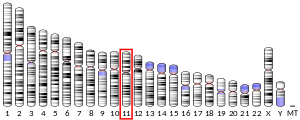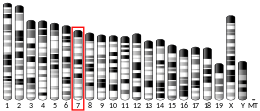ANO1
Anoctamin-1 (ANO1) also known as Transmembrane member 16A (TMEM16A) is a protein that, in humans, is encoded by the ANO1 gene.[5][6] Anoctamin-1 is a voltage-gated calcium-activated anion channel, which acts as a chloride channel[7] and a bicarbonate channel.[8]
It is expressed in smooth muscle, epithelial cells,[9] vomeronasal neurons,[10] and is highly expressed in human interstitial cells of Cajal (ICC) throughout the gastrointestinal tract.[11]
Function
ANO1 is a transmembrane protein that functions as a calcium-activated chloride channel.[12] Ca2+, Sr2+, and Ba2+ activate the channel.[13]
Structure
No atomic resolution structure of this channel has yet been obtained.[14] However, biochemical evidence suggests that the channel assembles as a dimer of two ANO1 polypeptide subunits.[15][16] From hydropathy plotting, each subunit is thought to encode a molecule with eight transmembrane domains, with a reentrant loop between the fifth and sixth transmembrane domains. The reentrant loop is thought to be a P loop-like structure responsible for the ion selectivity of the protein.[17]
Clinical significance
In mice, the functional expression of the ANO1 channel is essential to life, as its absence leads to a premature death due to respiratory collapse.[18]
ANO1 is expressed in the human gastrointestinal epithelium and is highly expressed in the gastrointestinal interstitial cells of Cajal, where it plays an important role in epithelial chloride secretion mediating intestinal motility.[11][19][9] ANO1 blockers like niflumic acid have been shown to block slow waves, which produce motility, in the human intestine.[11][19] ANO1-knockout mice fail to produce slow waves altogether.[11][19] Carbachol has been shown to markedly activate the channel;[11][19] in light of this, it's not surprising that secretory diarrhea is a Carbachol overdose symptom.[20] Crofelemer, an antidiarrhoeal, inhibits this channel.[21][22] Consequently, ANO1 activation is necessary for normal function of the ICC and its generated pacemaker activity in the smooth muscles of the intestine.[11][19]
Its overexpression was reported in esophageal squamous cell carcinoma and breast cancer progression.[23][24]
References
- GRCh38: Ensembl release 89: ENSG00000131620 - Ensembl, May 2017
- GRCm38: Ensembl release 89: ENSMUSG00000031075 - Ensembl, May 2017
- "Human PubMed Reference:". National Center for Biotechnology Information, U.S. National Library of Medicine.
- "Mouse PubMed Reference:". National Center for Biotechnology Information, U.S. National Library of Medicine.
- "Entrez Gene: anoctamin 1, calcium activated chloride channel".
- Katoh M, Katoh M (June 2003). "FLJ10261 gene, located within the CCND1-EMS1 locus on human chromosome 11q13, encodes the eight-transmembrane protein homologous to C12orf3, C11orf25 and FLJ34272 gene products". International Journal of Oncology. 22 (6): 1375–81. doi:10.3892/ijo.22.6.1375. PMID 12739008.
- Yang YD, Cho H, Koo JY, Tak MH, Cho Y, Shim WS, et al. (October 2008). "TMEM16A confers receptor-activated calcium-dependent chloride conductance". Nature. 455 (7217): 1210–5. Bibcode:2008Natur.455.1210Y. doi:10.1038/nature07313. PMID 18724360.
- Jung J, Nam JH, Park HW, Oh U, Yoon JH, Lee MG (January 2013). "Dynamic modulation of ANO1/TMEM16A HCO3(-) permeability by Ca2+/calmodulin". Proceedings of the National Academy of Sciences of the United States of America. 110 (1): 360–5. Bibcode:2013PNAS..110..360J. doi:10.1073/pnas.1211594110. PMC 3538232. PMID 23248295.
- Pedemonte N, Galietta LJ (April 2014). "Structure and function of TMEM16 proteins (anoctamins)". Physiological Reviews. 94 (2): 419–59. doi:10.1152/physrev.00039.2011. PMID 24692353.
- Amjad A, Hernandez-Clavijo A, Pifferi S, Maurya DK, Boccaccio A, Franzot J, et al. (April 2015). "Conditional knockout of TMEM16A/anoctamin1 abolishes the calcium-activated chloride current in mouse vomeronasal sensory neurons". The Journal of General Physiology. 145 (4): 285–301. doi:10.1085/jgp.201411348. PMC 4380210. PMID 25779870.
- Sanders KM, Zhu MH, Britton F, Koh SD, Ward SM (February 2012). "Anoctamins and gastrointestinal smooth muscle excitability". Experimental Physiology. 97 (2): 200–6. doi:10.1113/expphysiol.2011.058248. PMC 3272164. PMID 22002868.
- Kunzelmann K, Tian Y, Martins JR, Faria D, Kongsuphol P, Ousingsawat J, et al. (August 2011). "Anoctamins". Pflügers Archiv. 462 (2): 195–208. doi:10.1007/s00424-011-0975-9. PMID 21607626.
- Ni YL, Kuan AS, Chen TY (2014). "Activation and inhibition of TMEM16A calcium-activated chloride channels". PLOS ONE. 9 (1): e86734. Bibcode:2014PLoSO...986734N. doi:10.1371/journal.pone.0086734. PMC 3906059. PMID 24489780.
- Pfam PF04547; PDB search for PF04547
- Fallah G, Römer T, Detro-Dassen S, Braam U, Markwardt F, Schmalzing G (February 2011). "TMEM16A(a)/anoctamin-1 shares a homodimeric architecture with CLC chloride channels". Molecular & Cellular Proteomics. 10 (2): M110.004697. doi:10.1074/mcp.M110.004697. PMC 3033684. PMID 20974900.
- Sheridan JT, Worthington EN, Yu K, Gabriel SE, Hartzell HC, Tarran R (January 2011). "Characterization of the oligomeric structure of the Ca(2+)-activated Cl- channel Ano1/TMEM16A". The Journal of Biological Chemistry. 286 (2): 1381–8. doi:10.1074/jbc.M110.174847. PMC 3020746. PMID 21056985.
- Xiao Q, Yu K, Perez-Cornejo P, Cui Y, Arreola J, Hartzell HC (May 2011). "Voltage- and calcium-dependent gating of TMEM16A/Ano1 chloride channels are physically coupled by the first intracellular loop". Proceedings of the National Academy of Sciences of the United States of America. 108 (21): 8891–6. Bibcode:2011PNAS..108.8891X. doi:10.1073/pnas.1102147108. PMC 3102354. PMID 21555582.
- Rock JR, O'Neal WK, Gabriel SE, Randell SH, Harfe BD, Boucher RC, Grubb BR (May 2009). "Transmembrane protein 16A (TMEM16A) is a Ca2+-regulated Cl- secretory channel in mouse airways". The Journal of Biological Chemistry. 284 (22): 14875–80. doi:10.1074/jbc.C109.000869. PMC 2685669. PMID 19363029.
- Zhu MH, Sung IK, Zheng H, Sung TS, Britton FC, O'Driscoll K, et al. (September 2011). "Muscarinic activation of Ca2+-activated Cl- current in interstitial cells of Cajal". The Journal of Physiology. 589 (Pt 18): 4565–82. doi:10.1113/jphysiol.2011.211094. PMC 3208225. PMID 21768263.
- Schulz M, Graefe T, Stuby K, Andresen H, Kupfermann N, Schmoldt A (2006). "Case report: acute unintentional carbachol intoxication". Critical Care. 10 (3): R84. doi:10.1186/cc4937. PMC 1550933. PMID 16740173.
- Biswal S (2014). "Crofelemer: In HIV Associated Diarrhea and Secretory Diarrhea - A Patent Perspective". Recent Patents on Anti-Infective Drug Discovery. 9 (2): 136–43. doi:10.2174/1574891x10666150408153356. PMID 25851117.
- Tradtrantip L, Namkung W, Verkman AS (January 2010). "Crofelemer, an antisecretory antidiarrheal proanthocyanidin oligomer extracted from Croton lechleri, targets two distinct intestinal chloride channels". Molecular Pharmacology. 77 (1): 69–78. doi:10.1124/mol.109.061051. PMC 2802429. PMID 19808995.
- Kashyap MK, Marimuthu A, Kishore CJ, Peri S, Keerthikumar S, Prasad TS, et al. (January 2009). "Genomewide mRNA profiling of esophageal squamous cell carcinoma for identification of cancer biomarkers". Cancer Biology & Therapy. 8 (1): 36–46. doi:10.4161/cbt.8.1.7090. PMID 18981721.
- Britschgi A, Bill A, Brinkhaus H, Rothwell C, Clay I, Duss S, et al. (March 2013). "Calcium-activated chloride channel ANO1 promotes breast cancer progression by activating EGFR and CAMK signaling". Proceedings of the National Academy of Sciences of the United States of America. 110 (11): E1026-34. doi:10.1073/pnas.1217072110. PMC 3600458. PMID 23431153.
Further reading
- Miwa S, Nakajima T, Murai Y, Takano Y, Sugiyama T (2008). "Mutation assay of the novel gene DOG1 in gastrointestinal stromal tumors (GISTs)". Journal of Gastroenterology. 43 (7): 531–7. doi:10.1007/s00535-008-2195-4. PMID 18648740.
- Liegl B, Hornick JL, Corless CL, Fletcher CD (March 2009). "Monoclonal antibody DOG1.1 shows higher sensitivity than KIT in the diagnosis of gastrointestinal stromal tumors, including unusual subtypes". The American Journal of Surgical Pathology. 33 (3): 437–46. CiteSeerX 10.1.1.690.7988. doi:10.1097/PAS.0b013e318186b158. PMID 19011564.
- Gomez-Pinilla PJ, Gibbons SJ, Bardsley MR, Lorincz A, Pozo MJ, Pasricha PJ, et al. (June 2009). "Ano1 is a selective marker of interstitial cells of Cajal in the human and mouse gastrointestinal tract". American Journal of Physiology. Gastrointestinal and Liver Physiology. 296 (6): G1370-81. doi:10.1152/ajpgi.00074.2009. PMC 2697941. PMID 19372102.
- Yang YD, Cho H, Koo JY, Tak MH, Cho Y, Shim WS, et al. (October 2008). "TMEM16A confers receptor-activated calcium-dependent chloride conductance". Nature. 455 (7217): 1210–5. Bibcode:2008Natur.455.1210Y. doi:10.1038/nature07313. PMID 18724360.
- Katoh M, Katoh M (May 2004). "Identification and characterization of TMEM16E and TMEM16F genes in silico". International Journal of Oncology. 24 (5): 1345–9. doi:10.3892/ijo.24.5.1345. PMID 15067359.
- Hartzell HC, Yu K, Xiao Q, Chien LT, Qu Z (May 2009). "Anoctamin/TMEM16 family members are Ca2+-activated Cl- channels". The Journal of Physiology. 587 (Pt 10): 2127–39. doi:10.1113/jphysiol.2008.163709. PMC 2697287. PMID 19015192.
External links
- Human ANO1 genome location and ANO1 gene details page in the UCSC Genome Browser.



